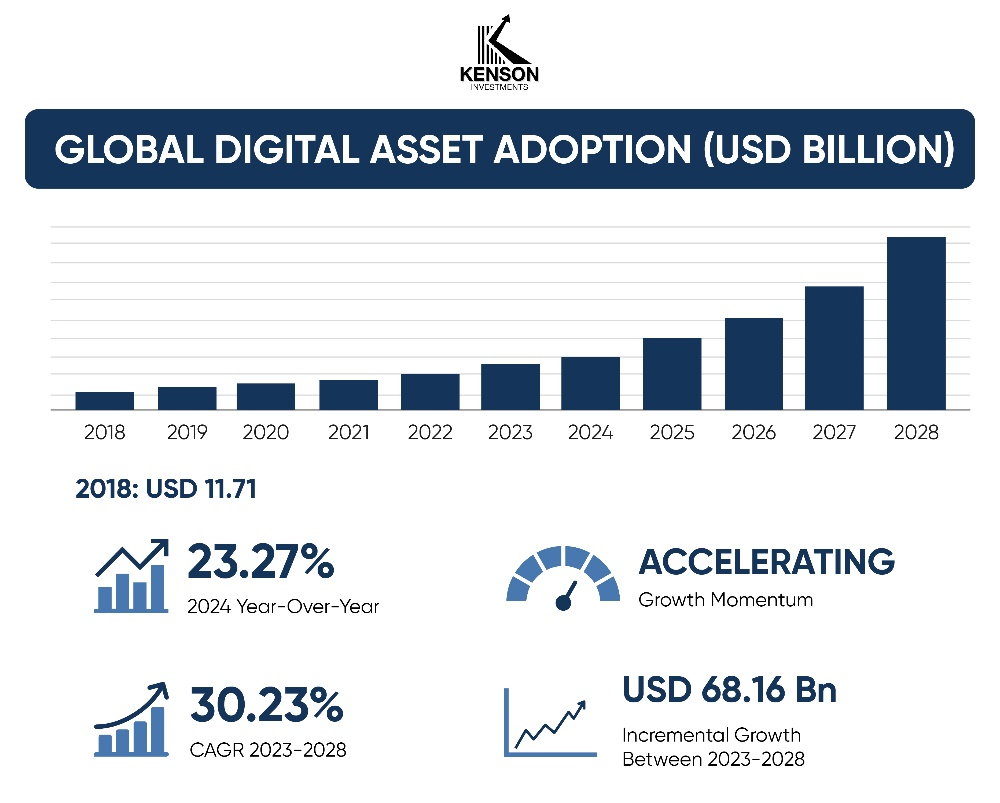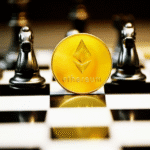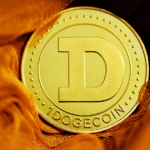
The digital asset landscape has evolved dramatically in recent years, with a surge in global adoption and a broadening scope of applications. This evolution is not just a trend but a significant shift in how value is created, managed, and transferred across the globe. As we look to the future, the trajectory of digital asset adoption offers both tremendous opportunities and complex challenges.
The Current State of Digital Asset Adoption
Digital assets, including cryptocurrencies, tokenized assets, and decentralized finance (DeFi) products, have moved beyond niche communities into broader financial and economic systems. Institutional investment in digital assets has surged, with major financial institutions and corporations increasingly incorporating cryptocurrencies into their portfolios and payment systems. This trend is bolstered by advancements in blockchain technology, which enhance security, transparency, and efficiency.
Governments and regulatory bodies are also playing a crucial role, as they work to establish frameworks that support innovation while addressing risks. Countries like El Salvador have embraced Bitcoin as a legal tender, while others are exploring central bank digital currencies (CBDCs) to modernize their financial systems.
Despite this progress, challenges remain. Market volatility, regulatory uncertainty, and security concerns continue to impact the adoption trajectory. However, the increasing institutional interest and technological advancements suggest a robust future for digital assets, as they gradually become integral to the global financial ecosystem.
Recommended Read: Global Adoption of Digital Assets: An Introduction
Emerging Trends in Digital Asset Adoption
Several key trends are shaping the future of digital asset adoption:
Institutional Investment Surge
The institutional investment in digital assets has seen unprecedented growth. Major financial institutions, including banks and asset managers, are increasingly integrating digital assets into their portfolios.
Firms like BlackRock and Fidelity have launched cryptocurrency investment products, signaling a strong belief in the long-term value of digital assets. The entry of institutional players not only adds legitimacy to digital assets but also enhances market liquidity and stability.
Mainstream Financial Integration
The integration of digital assets with traditional financial systems is a major trend. Central Bank Digital Currencies (CBDCs) are being explored by numerous countries, aiming to combine the efficiency of digital assets with the stability of fiat currencies.
Additionally, financial institutions are developing products and services that bridge the gap between traditional and digital finance, such as crypto-friendly banking services and digital asset custody solutions.
Digital assets are increasingly being integrated into mainstream financial systems. Payment processors like PayPal and Square have made it easier for users to buy, sell, and hold cryptocurrencies.
Regulatory Developments
Regulatory frameworks around digital assets are maturing globally. Countries like the United States, the European Union, and Singapore are developing clearer regulations to address the risks and opportunities posed by digital assets. These regulations aim to protect investors while fostering innovation. The balance between regulation and innovation will be crucial in determining the pace and sustainability of digital asset adoption.
Rise of Decentralized Finance (DeFi)
Decentralized Finance (DeFi) has emerged as a revolutionary trend in the digital asset space. DeFi platforms provide financial services such as lending, borrowing, and trading without intermediaries. The growth of DeFi is driven by the promise of increased accessibility, transparency, and efficiency in financial transactions. With billions of dollars locked in DeFi protocols, the sector is poised to play a significant role in the future of digital asset adoption.
| The growth of DeFi is driven by:
Smart Contracts: These self-executing contracts with coded rules and conditions facilitate automated and transparent financial transactions.
Yield Farming and Staking: Innovative mechanisms for earning returns on digital assets are attracting both retail and institutional investors. |
Institutional and Enterprise Integration
Businesses and enterprises are integrating digital assets into their operations, which drives further adoption:
Corporate Treasury Management: Companies are using digital assets for treasury management and cross-border transactions, benefiting from faster and cheaper transactions compared to traditional methods.
Partnerships: Collaborations between traditional financial institutions and digital asset companies facilitate the development of hybrid products and services.
NFTs and Digital Ownership
Non-Fungible Tokens (NFTs) have gained significant attention for their role in digital ownership and creative industries. NFTs represent unique digital assets that can be used to verify ownership and authenticity of digital art, collectibles, and other creative works. As the NFT market matures, it has the potential to revolutionize various industries, including art, gaming, and entertainment.

Technological Advancements Shaping the Future of Digital Assets
Scalability Solutions
Scalability remains a critical challenge for many digital asset platforms. However, advancements such as Layer 2 solutions (e.g., the Lightning Network for Bitcoin) and next-generation blockchains (e.g., Ethereum 2.0) are addressing these issues. These technologies aim to increase transaction throughput and reduce costs, making digital assets more practical for everyday use.
Interoperability
Interoperability between different blockchain networks is essential for the seamless transfer of digital assets and data. Projects like Polkadot and Cosmos are developing protocols that enable interoperability across diverse blockchain ecosystems. As these solutions become more refined, they will facilitate greater integration and functionality within the digital asset space.
Enhanced Security Measures
As digital assets become more mainstream, security and privacy are becoming top priorities. Advances in cryptographic techniques and security protocols are crucial for protecting digital assets from theft and fraud. Innovations such as multi-signature wallets, hardware wallets, and decentralized identity solutions are enhancing the security and privacy of digital transactions.
Smart Contracts and Automation
Smart contracts are self-executing contracts with the terms of the agreement directly written into code. They enable automated and trustless transactions, reducing the need for intermediaries. As smart contract technology evolves, it will unlock new possibilities for decentralized applications (dApps) and automate complex processes across various industries.
Decentralized Identity and Privacy
Decentralized identity solutions are gaining traction as a way to enhance user privacy and control over personal data. Projects like Sovrin and uPort are developing decentralized identity systems that allow users to manage and share their personal information securely. These technologies are expected to play a significant role in the future of digital asset adoption by addressing privacy concerns and streamlining user interactions.
Challenges Facing Digital Asset Adoption
Despite the promising trends, several challenges could impact the future of digital asset adoption:
Regulatory Uncertainty
Regulatory uncertainty remains a significant challenge. Different countries have varying approaches to digital asset regulation, ranging from supportive to restrictive. This fragmentation can create confusion and hinder global adoption. Key regulatory issues include:
Taxation: The treatment of digital assets for tax purposes varies, affecting investor behavior and market dynamics.
Compliance: Financial institutions and businesses must navigate complex regulatory requirements to offer digital asset services.
Scalability and Infrastructure Issues
Scalability is a critical issue for many blockchain networks. As transaction volumes increase, networks may struggle to handle the load, leading to higher fees and slower processing times. Solutions such as layer-2 scaling and blockchain interoperability are being developed to address these challenges, but widespread adoption will require further advancements.
Market Volatility
Digital assets are known for their price volatility, which can deter potential investors and users. Market fluctuations are influenced by various factors, including regulatory news, technological developments, and macroeconomic trends. Mitigating volatility through innovative financial products and risk management strategies will be essential for fostering long-term adoption.
Cybersecurity Threats
The rise of digital assets has also led to an increase in cybersecurity threats. Hackers and malicious actors target exchanges, wallets, and smart contracts to steal assets and disrupt services. Ensuring robust cybersecurity measures and developing new technologies to combat these threats will be crucial for maintaining trust in digital assets.

Opportunities for Future Growth
Despite the challenges, several opportunities exist for the future growth of digital asset adoption:
Financial Inclusion
Digital assets have the potential to enhance financial inclusion by providing access to financial services for unbanked and underbanked populations. Blockchain technology can facilitate cross-border transactions, reduce remittance costs, and provide access to financial products in regions with limited banking infrastructure.
Innovation in Business Models
Businesses are exploring innovative models that leverage digital assets to create new value propositions. For example, companies are using tokenization to raise capital through Initial Coin Offerings (ICOs) and Security Token Offerings (STOs). Additionally, blockchain technology is being used to improve supply chain transparency, streamline operations, and enhance customer engagement.
Collaboration Between Traditional and Digital Finance
Collaboration between traditional financial institutions and digital asset companies can drive innovation and create new opportunities. Partnerships and joint ventures can facilitate the development of hybrid financial products and services, combining the best features of traditional finance with the advantages of digital assets.
Chart Your Course in the Evolving Digital Asset Landscape
Register yourself now at Kenson Investments! Our expert team leverages cutting-edge technology and market insights to help you navigate the dynamic world of digital asset portfolio management and cryptocurrency investment solutions with confidence.
Whether you’re exploring new investment opportunities such as stablecoins for investment or altcoin investment, or seeking to optimize your current portfolio, the team of digital asset specialists is always available to provide personalized services and innovative solutions.
Call now for more information.














